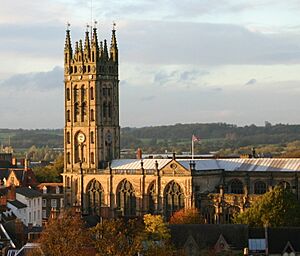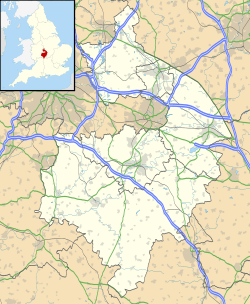Collegiate Church of St Mary, Warwick facts for kids
Quick facts for kids Collegiate Church of St Mary, Warwick |
|
|---|---|

Tower and nave of the church as viewed from Warwick Castle
|
|
| 52°16′56″N 1°35′17″W / 52.28222°N 1.58806°W | |
| Location | Old Square |
| Country | England |
| Denomination | Church of England |
| Churchmanship | High Church |
| Website | website |
| History | |
| Founded | 1123-? |
| Dedication | Blessed Virgin Mary |
| Administration | |
| Parish | Warwick, St Mary |
| Deanery | Warwick & Leamington |
| Archdeaconry | Warwick |
| Diocese | Coventry |
| Province | Canterbury |
The Collegiate Church of St Mary is a very old and important church in Warwick, England. It is a Church of England parish church located right in the middle of the town, near the market. This church is considered a Grade I listed building, which means it's a really special historical site. It's also part of the Major Churches Network, a group of large and important churches.
St Mary's is called a collegiate church because it used to have a group of priests, called canons, who lived and worked there. This made it similar to a cathedral in how it was run and the services it held. However, it's not a cathedral because it's not the main church for a bishop. While there is a Bishop of Warwick, this person is a special assistant bishop for the Diocese of Coventry.
Contents
History of St Mary's Church
How the Church Started
The story of St Mary's Church began over 900 years ago! It was founded in 1123 by Roger de Beaumont, 2nd Earl of Warwick. He also set up the group of priests, or college, at the church. The only part of the original church that still stands today is the crypt, which is an underground room. This part shows the old Norman architecture style.
Later, in the 14th century, another important person named Thomas Beauchamp, 11th Earl of Warwick, rebuilt many parts of the church. He used a style called Perpendicular Gothic, which has tall, straight lines and large windows. Between 1370 and 1394, more parts of the church were rebuilt, including the main hall (nave) and side areas (aisles).
The family of Thomas Beauchamp also built a special part called the Chapel of Our Lady, which is usually known as the Beauchamp Chapel. This chapel holds the tombs of several important people, including Richard de Beauchamp, 13th Earl of Warwick, Ambrose Dudley, 3rd Earl of Warwick, and Robert Dudley, 1st Earl of Leicester. Another famous person buried in the church is William Parr, 1st Marquess of Northampton, who was the brother of Queen Catherine Parr.
From the 1500s Onwards
In 1546, the college of priests at the church was closed down. The church then became the property of the townspeople of Warwick. Before they were destroyed in the English Civil War, many of the beautiful stained glass windows in the Beauchamp Chapel were copied by an artist named Wenceslaus Hollar. These copies showed the family symbols of the Beauchamp family.
In 1693, a terrible event called the Great Fire of Warwick destroyed much of the town, including parts of St Mary's Church. The main hall (nave) and the tower were completely ruined. But the church was rebuilt! By 1704, the new church was finished. It was designed in a Gothic style by William Wilson. Some people think that the famous architect Christopher Wren also helped with the design, but this is not certain. The church's tower stands very tall, reaching about 130 feet (40 metres) high.
The church had some important repair work done in 2023. This work cost about £1.4 million and was planned after a piece of stone fell from the church's tower. The repairs were completed by the end of 2023.
Leaders of the College
The church had special leaders called Deans when it was a college. Here are some of them:
- Robert Plesset, 1282
- Thomas de Sodynton, 1290
- William de Apperley, 1297
- Robert Tankard, 1306
- Richard de Alcester, 1313
- Robert de Geryn, 1314
- Robert de Lee, 1321
- Thomas Lench, 1338
- Robert de Endredeby, 1340
- Nicholas Southam, 1361
- Thomas Yonge, 1395
- John Porter, 1432
- Robert Cherbury, 1443
- William Berkswell, 14
- John Southwell, 1469
- Edmund Albone, M.D., 1481
- Richard Brackenburgh, 1485
- William Stokedale, 1498
- Edward Haseley, 1498
- Ralph Colingwode, 1507
- John Allestre, 1510
- John Carvanell, 1515
- John Knightley, 1542
Music at St Mary's
Church Organs
St Mary's Church has two organs! One is in the transept (a part of the church that crosses the main hall), and the other is at the west end. These organs have been rebuilt and updated over the years. The West End Organ was built in 1980, but its beautiful case with golden pipes looks much older.
Music Leaders and Organists
Music has always been a big part of St Mary's. Many talented musicians have played the organ and led the music here. Before 1976, the main musician was called the Organist. After 1976, the role changed to Director of Music.
Here are some of the people who have held these important music roles:
- Early Organists: William Witteney (1409), John Soursby (1432), John Skyrrowe (1562), Richard Charpe (1565), Thomas Dean (1719), William Dean (1744), Jonathan Hobbs (1773), Mary Hobbs (1787), Mrs R. Hobbs (1801), James Marshall (1802), Edward Dearle (1833), William Clayton (1844), W. Wyver (1861), James Shaw (1864), D. Middleton (1864), Bernard Farebrother (1867), Edwin Aspa (1871), A.J. Sutton (1874), Hanson de la Haye Blackith (1882), William Bellamy (1886), William McDuff (1894), Allen Blackall (1898), Peter Burton (1946), Thomas Tunnard (1950), Douglas Clarke (1958), Geoffrey Holroyde (1962), Andrew Fletcher (1973).
- Directors of Music: Andrew Fletcher (1976), Paul Trepte (1981), Simon Lole (1985), Mark Shepherd (1994), Chris Betts (1998), Katherine Dienes (2001-2007), Thomas Corns (2008-2017), Oliver Hancock (2018-present).
- Assistant Organists: Arthur Wills (1946-48), Edward Higginbottom (1965-67), Colin Roy (1967-1969), Andrew Fletcher (1971-73), Arthur Hilyer (1974), Tim Peters, Charles Matthews (1987-89).
- Organists (from 1989): Kevin Bowyer (1989), Christopher Monks (1998).
- Organists and Assistant Directors of Music: Christopher Monks (1999), Luke Bond (2002), Ruaraidh Sutherland (2006), Mark Swinton (2011-present).
Image gallery


























